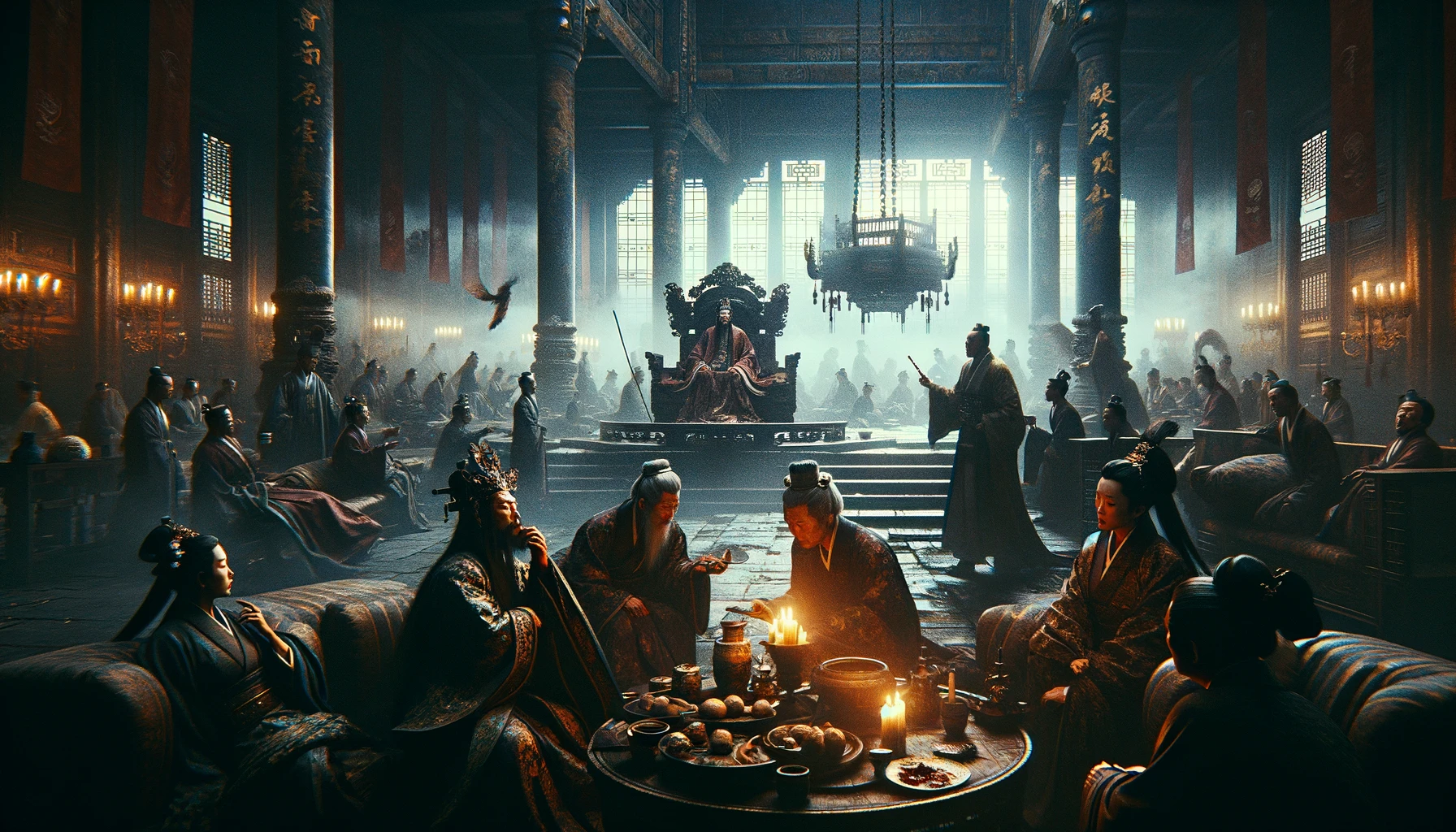Introduction
Often shrouded in myth, the Xia Dynasty stands as a foundational pillar within the chronicles of ancient China. Historians believe this dynasty emerged around 2070 BC, with Yu the Great credited as its legendary founder. The Xia are said to have developed a sophisticated understanding of flood control and initiated China’s hereditary monarchy system. Though surrounded by an air of legend, was the Xia a dynasty of reality or simply a mythical construct interwoven into the fabric of Chinese history?
Key Takeaways
- The Xia Dynasty, considered China’s first, is steeped in both history and myth.
- Yu the Great is famed for taming the Yellow River’s destructive floods through ingenious irrigation efforts.
- The Xia potentially introduced bronze metallurgy, advanced flood control systems, and early calendar systems to ancient China.
- Archaeological discoveries at sites like Erlitou hint at the dynasty’s existence, yet its full story remains elusive.
- The legacy of the Xia Dynasty likely played a pivotal role in shaping the philosophies and governance of later Chinese dynasties.
The Xia Dynasty: Myth or Reality?

Who was Yu the Great?
At the heart of the Xia Dynasty legend stands Yu the Great, a revered emperor credited with establishing this pioneering kingdom. Yu’s name has become synonymous with the epic struggle to control the raging waters of the Yellow River through a vast system of canals and dikes. His legendary efforts are said to have taken decades, exemplifying the power of human ingenuity and an unwavering determination akin to modern efforts in constructing the Hoover Dam.
What led to the Xia Dynasty’s downfall?

While the origins of the Xia Dynasty are cloaked in the mists of time, ancient texts provide a glimpse into its eventual decline. Accounts speak of internal decay, corruption slowly eroding the kingdom’s foundations, and a succession of ineffective rulers. Jie, depicted as the last and most tyrannical Xia emperor, is said to have lost the support of the people through his excesses and cruelty.
Who destroyed the Xia Dynasty?
According to traditional Chinese histories, the Xia Dynasty ultimately met its demise at the hands of the rising Shang Dynasty. Led by the legendary King Tang, the Shang are credited with overthrowing the crumbling Xia kingdom, ushering in a new era of dynastic rule.
Archaeological Evidence: Searching for the Xia

The quest to substantiate the existence of the Xia Dynasty has captivated archaeologists for decades. A potential link lies in the remnants of the Erlitou culture, flourishing around 1900-1500 BC in the Yellow River valley. Discoveries at Erlitou have uncovered the ruins of palaces, bronze artifacts, and evidence of advanced urban centers – all tantalizing clues pointing toward the existence of an ancient, sophisticated civilization.
However, the debate rages on as to whether these archaeological finds definitively establish the Xia Dynasty as a historical reality or if they represent an entirely separate culture. Like a complex riddle, each new piece of evidence only deepens the mystery surrounding China’s purported first dynasty.
Life and Legacy of the Xia Dynasty

Innovations and Achievements
Even amidst the shroud of myth and uncertainty, the Xia Dynasty is heralded for a number of groundbreaking innovations and achievements that may have profoundly shaped the course of ancient Chinese civilization.
What was the Xia Dynasty known for? Foremost among these is their reputed mastery of flood control. The ingenious systems of canals and dikes attributed to Yu the Great not only tamed the destructive power of the Yellow River but also paved the way for the development of large-scale agriculture and early urban settlements.
Additionally, archaeological findings suggest the Xia Dynasty may have played a pivotal role in the advent of bronze metallurgy in ancient China. The Erlitou culture’s exquisite bronze artifacts hint at an advanced understanding of metalworking techniques that would become integral to later Chinese dynasties.
Certain historians even propose that the Xia Dynasty developed one of the world’s earliest calendar systems, though concrete evidence remains scarce.
The Xia Dynasty and Chinese Culture
Beyond these technological and agricultural innovations, the Xia Dynasty’s legacy is also believed to have laid the foundations for quintessential aspects of Chinese culture and governance. The concept of a hereditary monarchy system, with power passed down from emperor to emperor, is thought to have originated during the Xia reign.
This system would go on to shape the philosophies and ruling structures of subsequent dynasties, becoming an indelible part of the Chinese political tradition. The principles of Confucianism, emphasizing social harmony, filial piety, and the ideal of the “enlightened ruler,” can also trace their roots back to the ethical frameworks established during the Xia era.
Xia Dynasty map

While no definitive map of the Xia’s territories exists, historians and archaeologists have used ancient texts and the distribution of Erlitou sites to hypothesize that the dynasty’s sphere of influence may have encompassed large swaths of the Yellow River valley in what is now central China.
Conclusion
Whether the Xia Dynasty was a historical reality or a mythical allegory interwoven into the grand tapestry of ancient Chinese history remains an enigma. Yet, its legacy and influence are undeniable, echoing through the ages and shaping the very fabric of Chinese civilization as we know it today.
As archaeologists continue to unearth clues and piece together fragments of evidence, perhaps a clearer picture will emerge – one that confirms the elusive Xia Dynasty as a true and pivotal epoch in ancient China’s rich narrative. For as the novelist L.P. Hartley eloquently stated, “The past is a foreign country; they do things differently there.” And sometimes, even within the realm of myths, fragments of truth can be found, as author Cassandra Clare reminds us: “Sometimes even myths contain fragments of truth.”
FAQ
Q: Did the Xia Dynasty really exist?
A: The existence of the Xia Dynasty remains a subject of ongoing debate among historians and archaeologists. While ancient Chinese historical texts vividly describe this purported first dynasty, conclusive archaeological proof has yet to be uncovered, leaving its status shrouded in mystery.
Q: How did the Xia Dynasty fall?
A: According to traditional accounts, the Xia Dynasty ultimately fell victim to internal corruption, societal decay, and a succession of incompetent rulers. The last Xia emperor, Jie, is depicted as a cruel and tyrannical figure who lost the support of the people, paving the way for the rise of the Shang Dynasty.
Q: Where was the Xia Dynasty located?
A: While no definitive borders have been established, historians speculate that the Xia Dynasty’s sphere of influence was primarily centered around the Yellow River Valley in what is now central China. The distribution of archaeological sites belonging to the Erlitou culture, considered a possible precursor to the Xia, provides clues as to the dynasty’s potential geographical extent.
Q: What was the Xia Dynasty known for?
A: The Xia Dynasty is attributed with several groundbreaking innovations and achievements that may have profoundly influenced the course of ancient Chinese civilization. These include advanced flood control and irrigation systems, the development of bronze metallurgy, and potentially one of the world’s earliest calendar systems. The Xia are also believed to have laid the foundations for the hereditary monarchy system and philosophical principles that would shape later Chinese dynasties.


